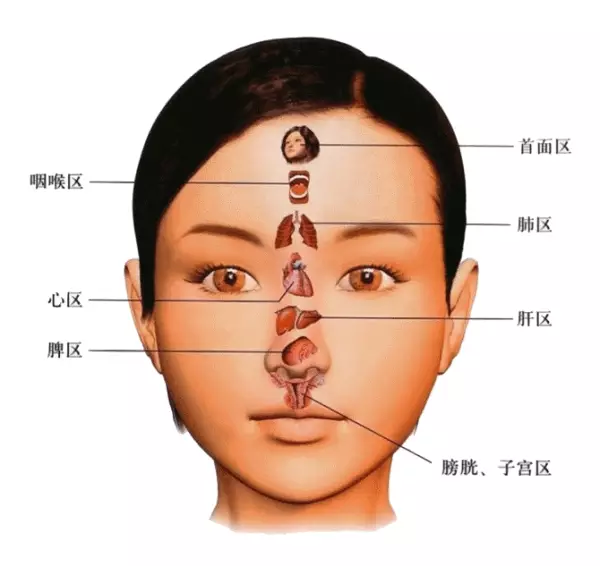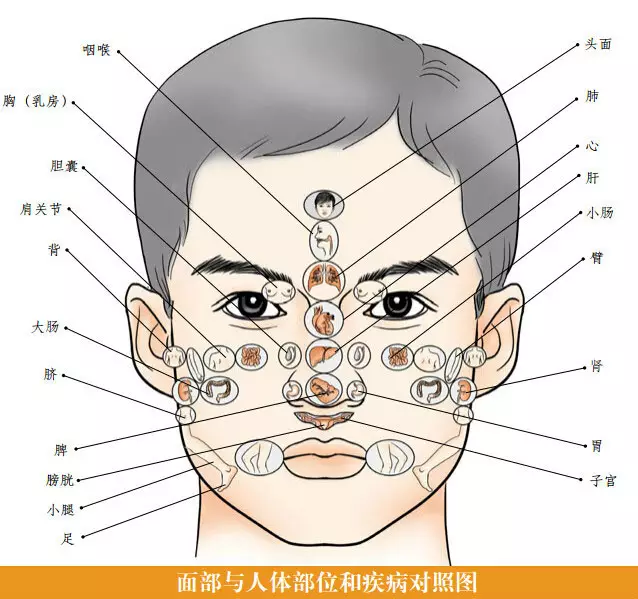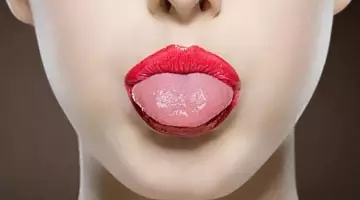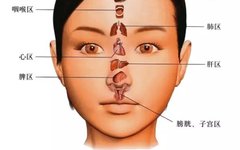Facial Diagnosis is a part of the essence of Traditional Chinese Medicine (TCM) developed over thousands of years, and is one of the four diagnostic methods in TCM: “Observation, Listening, Inquiry, and Palpation.” A healthy person’s face should be clean, with a rosy and lustrous complexion. Newborns typically have clean faces; however, as they grow older, various factors such as air, water, food additives, environmental pollution, genetic changes, and mental stress can harm health, leading to symptoms appearing on the face. Assessing Health Through Facial Color1. Yellow: Indicates issues with the spleen and stomach, digestive system;2. White: Indicates issues with the lungs, respiratory system;3. Red: Indicates issues with the cardiovascular system;4. Blue: Indicates issues with the liver and gallbladder, immune system;5. Black: Indicates issues with the kidneys and bladder.

 “Facial Features” A baby’s face is clean, but once they start eating solid food after weaning, it begins to reflect the function of the heart, liver, spleen, stomach, kidneys, and the five organs. As they age, more conditions manifest on the face, such as acne, blemishes, scars, and wrinkles. Generally, teenagers show acne, middle-aged individuals show wrinkles, and the elderly show spots.1. Moles and Nevi on the Face: Indicate congenital functional deficiencies of the corresponding organs.2. Facial Spots: Indicate chronic diseases formed by long-term depletion (3-5 years).3. Acne: Indicates current inflammatory changes in the corresponding organs (short-term formation).4. Widespread Acne and Spots: Indicate endocrine disorders or decreased liver immune function.“Specific Areas”1. Cardiovascular Stress Area: Most likely to show acne, spots, and wrinkles.2. Heart Area: Horizontal lines (one, two, or several) often indicate heart issues. Nasal lines often indicate insufficient blood supply.3. Brain Area: Vertical lines (between the inner corners of the eyebrows, or three or two lines) indicate poor cardiovascular health. A red glabella indicates thick blood lipids, often associated with hypertension.4. Liver Area: Shows crow’s feet and spots.5. Gallbladder Area: Appears bluish.6. Spleen and Stomach Area: Abnormal color (or red nose) often indicates disharmony of the spleen and stomach.7. Lung Area: Appears dark and sunken, indicating poor lung function.8. Kidney Area: Appears dark, indicating kidney deficiency. Red bumps indicate lower back pain and general soreness; sunken areas on the cheeks indicate kidney deficiency, and small ears indicate kidney deficiency.9. Bladder Area: Appears dark and dull, with acne; indicates bladder issues.10. Large and Small Intestine Areas: Show spots and “dark-colored” red dots indicating poor liver function.11. Reproductive Area: Abnormal color, often bluish, indicates endocrine disorders.12. Chest and Breast Area: Dark color, with one side corresponding to the other.“Facial Diagnosis” Facial diagnosis is mainly divided into twelve parts: namely “Heart, Brain, Liver, Gallbladder, Spleen, Lung, Kidney, Bladder, Large Intestine, Small Intestine, Reproductive, Chest and Breast.”HeartCardiovascular Stress Reflex Area: Located on the forehead from one-third to the hairline (the hairline circle).1. If acne appears here, or if the forehead color differs, it indicates significant psychological stress.2. If there are spots here, it indicates heart disease (e.g., myocardial insufficiency).3. If there are moles or nevi here, it indicates congenital heart function deficiency.Heart Reflex Area: Located between the inner corners of the eyes on the bridge of the nose.4. If horizontal lines appear or are prominent, it indicates arrhythmia or poor heart condition.5. If deep horizontal lines appear, and there are also deep vertical lines (grooves) on the tongue, it may indicate severe heart disease.6. Individuals with heart issues often have red blood vessels on their faces, resembling many small insects crawling, indicating poor blood circulation.Facial Diagnosis Analysis Individuals with heart issues often have a cheerful demeanor, always smiling, giving the impression of being happy, even when alone. Their diet tends to include bitter foods, such as bitter melon and bitter herbs, as their body requires these to replenish.People with heart issues often have a red complexion, but not a healthy red; it is a purplish-red.BrainBrain Reflex Area: Located between the eyebrows.1. If vertical lines appear here, and the area is red, it indicates insufficient blood supply to the heart and brain, headaches, neurasthenia, vivid dreams, poor sleep, palpitations, and irritability.2. If this area is red and shiny, it generally indicates hypertension.LiverLiver Reflex Area: The triangular area from the middle of the eyebrows to the outer ends, and the middle section of the nose is also the liver area.1. The liver governs the eyes: individuals with poor liver and gallbladder function often have poor eyesight, with yellowish and murky sclera, resembling nearsightedness or astigmatism, and may frequently blink due to weak liver function.2. Individuals with poor liver function may have horizontal or vertical lines on their nails, or gray nails. Their tendons may be bulging, with prominent veins, and in TCM, this is called “nails not smooth”; these individuals may experience cramps, which Western medicine attributes to calcium deficiency.3. Individuals with poor liver and gallbladder function tend to be irritable, easily angered over trivial matters.4. Individuals with poor liver and gallbladder function prefer sour foods, such as hawthorn and mountain apricots, and can eat a lot of them.5. Individuals with poor liver and gallbladder function often have a grayish-blue complexion, lacking luster, as if they haven’t washed their face.Pathological Analysis1. If these two areas appear bluish or have spots, it may indicate fatty liver.2. If acne appears in these areas, it indicates excessive liver fire.3. If spots appear on the temples, it indicates weakened liver function.4. If spots appear in the middle of the nose, it may indicate excessive liver fire, unstable emotions, or menopause.5. If both areas have noticeable spots and the complexion is dull and unattractive, indicating a thin person, it may suggest hepatitis or cirrhosis.6. A mole in the center of the eyebrows, yellow sclera, and a very yellow complexion may indicate hepatitis B.7. Soft, thin, dull nails with vertical lines that are prone to breakage indicate poor liver function.8. A face full of freckles may indicate congenital liver function deficiency.GallbladderGallbladder Reflex Area: Located on both sides of the middle section of the nose.1. If this area has red blood vessels, acne, or bitterness in the mouth upon waking, it indicates mild inflammation of the gallbladder.2. If there are spots or shadows, it may indicate cholecystitis.3. If this area has vertical wrinkles or shows vertical lines when smiling, it indicates gallbladder issues.4. If this area has moles or nevi, it indicates congenital gallbladder function deficiency.5. If you place your right hand under your right rib (where the gallbladder is located), and strike your right hand with a fist, if it hurts, it indicates cholecystitis;6. If the pain is severe, it may indicate gallstones. Individuals with gallbladder issues may be overweight.7. A pair of noticeable spots or moles under the eyes in the gallbladder area indicates gallstones. Dark eye bags also indicate poor gallbladder function.Spleen and StomachSpleen Reflex Area: Located on the tip of the nose; Stomach Reflex Area: Located on the wings of the nose, with the two sides being the duodenum area.1. Pale, bloodless lips, dry lips that easily crack, indicate poor spleen and stomach function.2. Individuals with poor spleen and stomach function have loose muscles and lack elasticity.3. Individuals with poor spleen and stomach function often frown as if deep in thought, even when there is nothing to worry about.4. Individuals with poor spleen and stomach function often have a yellow complexion; if someone has a yellow face and often frowns, they likely have poor spleen and stomach function.5. A red nose, rosacea, red blood vessels on the nose, black spots, and bumps indicate poor spleen and stomach function.6. A white, bloodless nose tip indicates spleen deficiency, which may lead to anemia. A yellow nose tip also indicates spleen deficiency, with symptoms such as excessive sweating, aversion to wind, fatigue, and lack of appetite.7. If the nostrils are always dirty, black, and oily, resembling unwashed skin, or if there are bumps, it indicates poor stomach function.8. If the nostrils are red, it indicates stomach fire, leading to hunger and bad breath. If there are severe red blood vessels, it generally indicates gastritis.9. If the nostrils are grayish-blue, it indicates stomach cold; when shaking hands, you can feel the person’s fingertips are cold, indicating they have stomach pain and diarrhea due to wind-cold.10. If spots or moles appear in the spleen area, it may indicate spleen enlargement; if spots and moles appear in the stomach area, it may indicate ulcers or other lesions.Clinical AnalysisStomach pain before meals generally indicates gastritis.Stomach pain one to two hours after meals indicates gastric ulcers, with tenderness in the middle of the abdomen or slightly to the left.Stomach pain two to four hours after meals indicates duodenal ulcers, with pain located between the ribs near the heart, similar to a needle prick; in severe cases, the pain may radiate to the back, with tenderness in the abdomen slightly to the right.Individuals with poor appetite tend to prefer sweet foods, as their body requires sweetness for replenishment.LungLung Reflex Area: Located between the eyebrows and halfway down the forehead, at the glabella position.Individuals with poor lung function often have nasal issues, such as allergic rhinitis, sinusitis, and frequent respiratory infections.The lungs nourish the skin and hair; individuals with poor lung function often have rough skin, large pores, and dull, brittle hair. Their emotions tend to be melancholic, often worrying and crying over trivial matters.Individuals with poor lung function tend to prefer spicy foods.Individuals with poor lung function often have a pale complexion, lacking blood color.Facial Diagnosis Analysis1. If the glabella is red, it indicates recent upper respiratory infections.2. If the glabella is dark, blackish, it may indicate disease; early hospital examination is advised.3. If the middle of the forehead is sunken, with a dull color, or bluish, or has spots, it indicates lung disease and difficulty breathing.4. If there are pimples, it indicates recent colds or sore throats.5. If there are moles or nevi on the eyebrows, it indicates pharyngitis, tonsillitis, chest tightness, or lung disease.6. If there is a bulge above the eyebrows, it also indicates lung disease.Individuals with poor lung function often have poor large intestine elimination function.KidneyKidney Reflex Area: Located at the intersection of the outer corner of the eyes and a vertical line from the middle of the ear down to the chin.1. If there are bumps or dark spots in this area, it is not due to lack of cleanliness or sun exposure, indicating poor kidney function.2. If this area has red blood vessels, acne, or spots, it indicates kidney deficiency, often accompanied by laziness and soreness in the lower back and legs.3. If there are deep and large spots in this area, it may indicate kidney stones. If black moles or bumps appear on the ears, it may indicate kidney stones.4. If there are moles or bumps in this area, it indicates congenital kidney function deficiency, which may also cause soreness in the lower back, legs, and back.5. Deep crow’s feet at the corners of the eyes and vertical wrinkles near the ears indicate declining kidney function.6. The chin is the area of kidney soreness. If red spots or bumps appear in this area, it indicates lower back pain, generally indicating nephritis.BladderBladder Reflex Area: Located on both sides of the philtrum at the root of the nose.1. If this area is red, with red blood vessels, acne, or sores, it indicates cystitis, which may cause symptoms such as yellow, frequent urination.2. If there are wrinkles in the bladder area, it may indicate kidney atrophy; red acne indicates inflammation, and later black moles may indicate disease.Large Intestine and RectumLarge Intestine Reflex Area: Located below the cheekbone, from the eyeball to the outer corner of the eye down to the corner of the mouth, this area corresponds to the large intestine.1. If this area has red blood vessels, acne, spots, moles, or nevi, it indicates poor large intestine elimination function, often leading to dry stools and constipation.2. If this area has crescent-shaped spots, it indicates constipation or hemorrhoids.3. If the large intestine area is dark red and uneven, it may indicate colitis.The intersection of the lower part of the nose and the line from the outer corner of the eye down is the rectum reflex area.If there are spots here, it indicates hemorrhoids; if this area is red or has white spots, it may indicate rectal cancer.Small IntestineSmall Intestine Reflex Area: Located on the inner side of the cheekbone.Individuals with heart disease generally have poor small intestine function.1. If this area has red blood vessels, acne, spots, moles, or nevi, it indicates poor small intestine absorption function, often leading to loose stools.Reproductive SystemReproductive System Reflex Area: Located around the philtrum and lips.1. If a woman has moles or nevi below her lips, and the kidney reflex area is relatively clean, it indicates a retroverted uterus and lower back pain.2. If a woman has moles or nevi around her lips, and the kidney reflex area is also poor; or if a woman’s lips are bluish, dark, or pale, and the kidney reflex area is also poor, these situations generally indicate sexual coldness.3. If there are bumps in the philtrum, it generally indicates uterine disease.4. If a man has moles or nevi around his lips, and the kidney reflex area is also poor, it indicates reproductive system issues.5. If a man has an uneven upper lip with grooves and vertical lines, it indicates male sexual dysfunction.Chest and BreastChest and Breast Reflex Area: The slope of the nose between the eyes is the chest and breast area.(1) If there are moles and spots in the breast area, it may indicate breast hyperplasia and tumors.As people age, kidney deficiency and kidney failure can lead to ear problems, such as tinnitus. Kidney deficiency can also lead to bladder, reproductive system, and gonadal diseases.Any skeletal issues can often be traced back to the kidneys; for example, osteoporosis, bone hyperplasia, herniated discs, and arthritis in the elderly are all caused by weakened kidney function.Individuals with poor kidney function often have fearful emotions, with a constant sense of fear. They may startle easily at sudden noises or movements. Their diet tends to be salty, with a particularly strong flavor.
“Facial Features” A baby’s face is clean, but once they start eating solid food after weaning, it begins to reflect the function of the heart, liver, spleen, stomach, kidneys, and the five organs. As they age, more conditions manifest on the face, such as acne, blemishes, scars, and wrinkles. Generally, teenagers show acne, middle-aged individuals show wrinkles, and the elderly show spots.1. Moles and Nevi on the Face: Indicate congenital functional deficiencies of the corresponding organs.2. Facial Spots: Indicate chronic diseases formed by long-term depletion (3-5 years).3. Acne: Indicates current inflammatory changes in the corresponding organs (short-term formation).4. Widespread Acne and Spots: Indicate endocrine disorders or decreased liver immune function.“Specific Areas”1. Cardiovascular Stress Area: Most likely to show acne, spots, and wrinkles.2. Heart Area: Horizontal lines (one, two, or several) often indicate heart issues. Nasal lines often indicate insufficient blood supply.3. Brain Area: Vertical lines (between the inner corners of the eyebrows, or three or two lines) indicate poor cardiovascular health. A red glabella indicates thick blood lipids, often associated with hypertension.4. Liver Area: Shows crow’s feet and spots.5. Gallbladder Area: Appears bluish.6. Spleen and Stomach Area: Abnormal color (or red nose) often indicates disharmony of the spleen and stomach.7. Lung Area: Appears dark and sunken, indicating poor lung function.8. Kidney Area: Appears dark, indicating kidney deficiency. Red bumps indicate lower back pain and general soreness; sunken areas on the cheeks indicate kidney deficiency, and small ears indicate kidney deficiency.9. Bladder Area: Appears dark and dull, with acne; indicates bladder issues.10. Large and Small Intestine Areas: Show spots and “dark-colored” red dots indicating poor liver function.11. Reproductive Area: Abnormal color, often bluish, indicates endocrine disorders.12. Chest and Breast Area: Dark color, with one side corresponding to the other.“Facial Diagnosis” Facial diagnosis is mainly divided into twelve parts: namely “Heart, Brain, Liver, Gallbladder, Spleen, Lung, Kidney, Bladder, Large Intestine, Small Intestine, Reproductive, Chest and Breast.”HeartCardiovascular Stress Reflex Area: Located on the forehead from one-third to the hairline (the hairline circle).1. If acne appears here, or if the forehead color differs, it indicates significant psychological stress.2. If there are spots here, it indicates heart disease (e.g., myocardial insufficiency).3. If there are moles or nevi here, it indicates congenital heart function deficiency.Heart Reflex Area: Located between the inner corners of the eyes on the bridge of the nose.4. If horizontal lines appear or are prominent, it indicates arrhythmia or poor heart condition.5. If deep horizontal lines appear, and there are also deep vertical lines (grooves) on the tongue, it may indicate severe heart disease.6. Individuals with heart issues often have red blood vessels on their faces, resembling many small insects crawling, indicating poor blood circulation.Facial Diagnosis Analysis Individuals with heart issues often have a cheerful demeanor, always smiling, giving the impression of being happy, even when alone. Their diet tends to include bitter foods, such as bitter melon and bitter herbs, as their body requires these to replenish.People with heart issues often have a red complexion, but not a healthy red; it is a purplish-red.BrainBrain Reflex Area: Located between the eyebrows.1. If vertical lines appear here, and the area is red, it indicates insufficient blood supply to the heart and brain, headaches, neurasthenia, vivid dreams, poor sleep, palpitations, and irritability.2. If this area is red and shiny, it generally indicates hypertension.LiverLiver Reflex Area: The triangular area from the middle of the eyebrows to the outer ends, and the middle section of the nose is also the liver area.1. The liver governs the eyes: individuals with poor liver and gallbladder function often have poor eyesight, with yellowish and murky sclera, resembling nearsightedness or astigmatism, and may frequently blink due to weak liver function.2. Individuals with poor liver function may have horizontal or vertical lines on their nails, or gray nails. Their tendons may be bulging, with prominent veins, and in TCM, this is called “nails not smooth”; these individuals may experience cramps, which Western medicine attributes to calcium deficiency.3. Individuals with poor liver and gallbladder function tend to be irritable, easily angered over trivial matters.4. Individuals with poor liver and gallbladder function prefer sour foods, such as hawthorn and mountain apricots, and can eat a lot of them.5. Individuals with poor liver and gallbladder function often have a grayish-blue complexion, lacking luster, as if they haven’t washed their face.Pathological Analysis1. If these two areas appear bluish or have spots, it may indicate fatty liver.2. If acne appears in these areas, it indicates excessive liver fire.3. If spots appear on the temples, it indicates weakened liver function.4. If spots appear in the middle of the nose, it may indicate excessive liver fire, unstable emotions, or menopause.5. If both areas have noticeable spots and the complexion is dull and unattractive, indicating a thin person, it may suggest hepatitis or cirrhosis.6. A mole in the center of the eyebrows, yellow sclera, and a very yellow complexion may indicate hepatitis B.7. Soft, thin, dull nails with vertical lines that are prone to breakage indicate poor liver function.8. A face full of freckles may indicate congenital liver function deficiency.GallbladderGallbladder Reflex Area: Located on both sides of the middle section of the nose.1. If this area has red blood vessels, acne, or bitterness in the mouth upon waking, it indicates mild inflammation of the gallbladder.2. If there are spots or shadows, it may indicate cholecystitis.3. If this area has vertical wrinkles or shows vertical lines when smiling, it indicates gallbladder issues.4. If this area has moles or nevi, it indicates congenital gallbladder function deficiency.5. If you place your right hand under your right rib (where the gallbladder is located), and strike your right hand with a fist, if it hurts, it indicates cholecystitis;6. If the pain is severe, it may indicate gallstones. Individuals with gallbladder issues may be overweight.7. A pair of noticeable spots or moles under the eyes in the gallbladder area indicates gallstones. Dark eye bags also indicate poor gallbladder function.Spleen and StomachSpleen Reflex Area: Located on the tip of the nose; Stomach Reflex Area: Located on the wings of the nose, with the two sides being the duodenum area.1. Pale, bloodless lips, dry lips that easily crack, indicate poor spleen and stomach function.2. Individuals with poor spleen and stomach function have loose muscles and lack elasticity.3. Individuals with poor spleen and stomach function often frown as if deep in thought, even when there is nothing to worry about.4. Individuals with poor spleen and stomach function often have a yellow complexion; if someone has a yellow face and often frowns, they likely have poor spleen and stomach function.5. A red nose, rosacea, red blood vessels on the nose, black spots, and bumps indicate poor spleen and stomach function.6. A white, bloodless nose tip indicates spleen deficiency, which may lead to anemia. A yellow nose tip also indicates spleen deficiency, with symptoms such as excessive sweating, aversion to wind, fatigue, and lack of appetite.7. If the nostrils are always dirty, black, and oily, resembling unwashed skin, or if there are bumps, it indicates poor stomach function.8. If the nostrils are red, it indicates stomach fire, leading to hunger and bad breath. If there are severe red blood vessels, it generally indicates gastritis.9. If the nostrils are grayish-blue, it indicates stomach cold; when shaking hands, you can feel the person’s fingertips are cold, indicating they have stomach pain and diarrhea due to wind-cold.10. If spots or moles appear in the spleen area, it may indicate spleen enlargement; if spots and moles appear in the stomach area, it may indicate ulcers or other lesions.Clinical AnalysisStomach pain before meals generally indicates gastritis.Stomach pain one to two hours after meals indicates gastric ulcers, with tenderness in the middle of the abdomen or slightly to the left.Stomach pain two to four hours after meals indicates duodenal ulcers, with pain located between the ribs near the heart, similar to a needle prick; in severe cases, the pain may radiate to the back, with tenderness in the abdomen slightly to the right.Individuals with poor appetite tend to prefer sweet foods, as their body requires sweetness for replenishment.LungLung Reflex Area: Located between the eyebrows and halfway down the forehead, at the glabella position.Individuals with poor lung function often have nasal issues, such as allergic rhinitis, sinusitis, and frequent respiratory infections.The lungs nourish the skin and hair; individuals with poor lung function often have rough skin, large pores, and dull, brittle hair. Their emotions tend to be melancholic, often worrying and crying over trivial matters.Individuals with poor lung function tend to prefer spicy foods.Individuals with poor lung function often have a pale complexion, lacking blood color.Facial Diagnosis Analysis1. If the glabella is red, it indicates recent upper respiratory infections.2. If the glabella is dark, blackish, it may indicate disease; early hospital examination is advised.3. If the middle of the forehead is sunken, with a dull color, or bluish, or has spots, it indicates lung disease and difficulty breathing.4. If there are pimples, it indicates recent colds or sore throats.5. If there are moles or nevi on the eyebrows, it indicates pharyngitis, tonsillitis, chest tightness, or lung disease.6. If there is a bulge above the eyebrows, it also indicates lung disease.Individuals with poor lung function often have poor large intestine elimination function.KidneyKidney Reflex Area: Located at the intersection of the outer corner of the eyes and a vertical line from the middle of the ear down to the chin.1. If there are bumps or dark spots in this area, it is not due to lack of cleanliness or sun exposure, indicating poor kidney function.2. If this area has red blood vessels, acne, or spots, it indicates kidney deficiency, often accompanied by laziness and soreness in the lower back and legs.3. If there are deep and large spots in this area, it may indicate kidney stones. If black moles or bumps appear on the ears, it may indicate kidney stones.4. If there are moles or bumps in this area, it indicates congenital kidney function deficiency, which may also cause soreness in the lower back, legs, and back.5. Deep crow’s feet at the corners of the eyes and vertical wrinkles near the ears indicate declining kidney function.6. The chin is the area of kidney soreness. If red spots or bumps appear in this area, it indicates lower back pain, generally indicating nephritis.BladderBladder Reflex Area: Located on both sides of the philtrum at the root of the nose.1. If this area is red, with red blood vessels, acne, or sores, it indicates cystitis, which may cause symptoms such as yellow, frequent urination.2. If there are wrinkles in the bladder area, it may indicate kidney atrophy; red acne indicates inflammation, and later black moles may indicate disease.Large Intestine and RectumLarge Intestine Reflex Area: Located below the cheekbone, from the eyeball to the outer corner of the eye down to the corner of the mouth, this area corresponds to the large intestine.1. If this area has red blood vessels, acne, spots, moles, or nevi, it indicates poor large intestine elimination function, often leading to dry stools and constipation.2. If this area has crescent-shaped spots, it indicates constipation or hemorrhoids.3. If the large intestine area is dark red and uneven, it may indicate colitis.The intersection of the lower part of the nose and the line from the outer corner of the eye down is the rectum reflex area.If there are spots here, it indicates hemorrhoids; if this area is red or has white spots, it may indicate rectal cancer.Small IntestineSmall Intestine Reflex Area: Located on the inner side of the cheekbone.Individuals with heart disease generally have poor small intestine function.1. If this area has red blood vessels, acne, spots, moles, or nevi, it indicates poor small intestine absorption function, often leading to loose stools.Reproductive SystemReproductive System Reflex Area: Located around the philtrum and lips.1. If a woman has moles or nevi below her lips, and the kidney reflex area is relatively clean, it indicates a retroverted uterus and lower back pain.2. If a woman has moles or nevi around her lips, and the kidney reflex area is also poor; or if a woman’s lips are bluish, dark, or pale, and the kidney reflex area is also poor, these situations generally indicate sexual coldness.3. If there are bumps in the philtrum, it generally indicates uterine disease.4. If a man has moles or nevi around his lips, and the kidney reflex area is also poor, it indicates reproductive system issues.5. If a man has an uneven upper lip with grooves and vertical lines, it indicates male sexual dysfunction.Chest and BreastChest and Breast Reflex Area: The slope of the nose between the eyes is the chest and breast area.(1) If there are moles and spots in the breast area, it may indicate breast hyperplasia and tumors.As people age, kidney deficiency and kidney failure can lead to ear problems, such as tinnitus. Kidney deficiency can also lead to bladder, reproductive system, and gonadal diseases.Any skeletal issues can often be traced back to the kidneys; for example, osteoporosis, bone hyperplasia, herniated discs, and arthritis in the elderly are all caused by weakened kidney function.Individuals with poor kidney function often have fearful emotions, with a constant sense of fear. They may startle easily at sudden noises or movements. Their diet tends to be salty, with a particularly strong flavor.
1. If the eyes suddenly become blurry, with dry corners and difficulty seeing. This is a precursor to weakened liver function. If you press around the liver, you may feel swelling. In addition to seeking timely medical attention, it is important to maintain eye hygiene and avoid excessive eye strain, as improper use of the eyes can also affect the liver.2. If the ears constantly buzz and sounds are unclear. This is a signal of gradually declining kidney function, sometimes accompanied by foot pain, lower back pain, and frequent urination. Those who work excessively should pay attention to balancing work and rest, avoiding overexertion, and reducing alcohol and spicy food intake.3. If the sense of smell is dull, with frequent coughing and sometimes even difficulty breathing. This is a sign of gradually declining lung function. Patients should first pay attention to their diet, quit smoking or control their smoking, and avoid being around heavy smokers. They should eat more fresh fruits and vegetables and strengthen physical exercise to prevent lung complications.4. If the lips feel numb, with reduced appetite and noticeable weight loss. This indicates gradually declining pancreatic function, mainly due to dietary imbalances and improper eating habits. When the pancreas is not functioning well, it affects the stomach, leading to noticeably dry and cracked lips, numbness, and lack of taste. In addition to adjusting the diet, it is also important to avoid eating raw, cold, or greasy foods.5. If the sense of taste is dull, with an inability to taste food, accompanied by palpitations, vivid dreams, and insomnia. This indicates damage to heart function. This is often caused by overwork; when the mouth feels dry, with a thick tongue coating, and the inability to taste food, it is especially important to be vigilant to prevent heart disease. Observing the Tongue
Observing the Tongue
· The End · Warm Reminder: This platform shares health-related graphic information for reference and learning purposes only, and should not be used as a basis for medical diagnosis. If needed, please consult a physician for guidance.⊙ Copyright Statement: The article is sourced from the internet; if there is any infringement, please contact us for removal.

Isn’t it incredible that you haven’t clicked “Read More”

